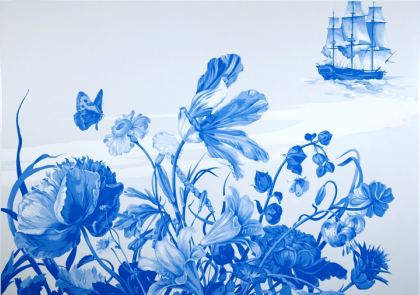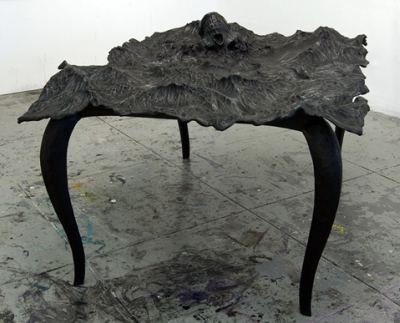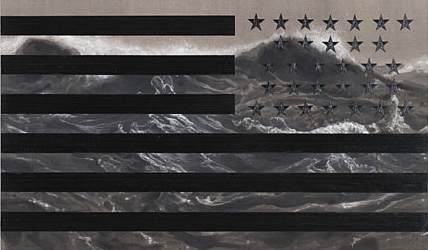Tony de los Reyes specializes in suppressed landscapes. When he paints women, they’re suppressed landscapes, too.
A couple of years ago he was painting in oil alkyd: creamy white grounds with blue figures. Those surfaces look shellacked but aren’t. Sometimes a bird (always blue) flies by, high overhead. Sometimes there are sheep, ships or flowers, and sometimes a tree leaning into the air from an outcropping of ground, inspired by a combination of delftware china and traditional Chinese landscape painting.
Image via: The Chase, 2004
 Recent paintings (and one sculpture) at Howard House could be called Fade to Black. Painted black space in ink and oil on linen overwhelms form, seeps into it and changes its character. His bright flowers are gone, replaced by the foam of a poisoned sea.
Recent paintings (and one sculpture) at Howard House could be called Fade to Black. Painted black space in ink and oil on linen overwhelms form, seeps into it and changes its character. His bright flowers are gone, replaced by the foam of a poisoned sea.
The Prophet, 2009, polyester resin, aluminum, wood.
 From delicacy he has moved to a bombast that resembles Robert Morris’ in the early 1980s. As Ricard Lacayo noted in 1984:
From delicacy he has moved to a bombast that resembles Robert Morris’ in the early 1980s. As Ricard Lacayo noted in 1984:
Two years ago, Robert Morris began showing a series of bas-relief
works that seemed to vent nuclear anxieties in a visual language of
medieval fatalism. Embedded in an infernal slurry of plaster, human
faces and fractured skeletons held the poses of apocalyptic death
agony. This year Morris returned to painting with a series of more
ambiguous abstractions. But a skeletal frieze has been retained along
the frame to specify the note of mortal dread.
Morris charted Dante’s Inferno. De Los Reyes is filtering Herman Melville through a lens of contemporary environmental degradation and economic collapse. De los Reyes’ paintings suggest the seeds of our ruin were there all along, in the chaos of our hearts. (William Carlos Williams: “The pure products of America go crazy.”)
1851:
 As with Morris, the bombast has a built-in problem. If it fails to overwhelm, it becomes its own parody. What de los Reyes has given up to get here is his subtlety, insouciance and tough-minded allure.
As with Morris, the bombast has a built-in problem. If it fails to overwhelm, it becomes its own parody. What de los Reyes has given up to get here is his subtlety, insouciance and tough-minded allure.
Also like Morris, what saves him are high craft values. His chaos is well made, which gives it focus and depth. After the white whale breeches and dives in 1851, the pool that churns in its wake under the stars in a backwards flag is a lizard’s eye.
Melville’s sea drove a boy stranded in it out of his mind. About rivers, however, Melville was more optimistic. From The Confidence Man:
Here reigned the dashing and all-fusing spirit of the West, whose type is the Mississippi itself, which, uniting the streams of the most distant and opposite zones, pours them along, helter-skelter, in one cosmopolitan and confident tide.
I miss in de los Reyes what he used to have in abundance, a sense of that cosmopolitan and confident tide.



Anyone know how to get to Howard House? I’ve never been.
Hi Sandy. The address, 604 2nd Ave., is on the link but not how to get there. It’s four or five blocks north of Pioneer Square. After misdirecting a car full of tourists a few years ago, realizing it only after they sailed off onto the freeway in the wrong direction, I promised myself I’d never give directions again. When asked, I always shrug and say I’m a visitor, even when standing on the block where I live. But Howard House? I think I’ve got that covered. Regina
Thanks bunches. Do you think someone there might be able to direct me to other galleries in the area as well?
Sandy. If you’re able to eat, drink, floss your teeth and find Jon Stewart online without paying for cable, in other words, live a normal life, you can get to any gallery in Seattle.
Sandy – Howard House is located on the north side of Pioneer Square on Second Avenue at James Street just one block north of the Smith Tower. When you come in we can give you the SADA magazine that has a great map for the PS galleries and beyond.